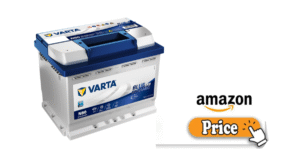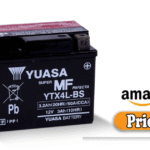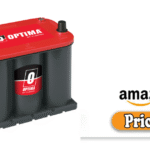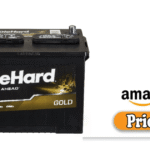When it comes to your car’s heart, the battery choosing the right battery can feel like defusing a ticking time bomb. Enter VARTA: a German brand synonymous with performance, German engineering, and longevity.
In this in-depth review, I’ll explore what makes VARTA car batteries tick, where they shine, how they falter, and why they might be the perfect fit for your ride.
1. What I Like
1. Exceptional Cold-Cranking Power
One of VARTA’s biggest selling points is its cold-cranking amps (CCA), often well above industry standard. Starting a car on a frigid morning? No drama, no strain on your starter motor.
2. Long-Lasting Reserve Capacity
With a deep-cycle reserve capacity, VARTA batteries can help you run accessories such as your music system, lights, and even heated seats for short periods without worrying about getting stranded.
3. Trusted German Engineering
VARTA isn’t just a name, it’s a legacy. Their batteries are engineered to tight tolerances and built with quality materials. That translates into fewer failures and consistent performance over time.
4. Wide Model Range & Easy Fit
From compact 4-cylinder apartments to luxury SUVs with high electronic loads, there’s a VARTA battery that fits your use case. Their labeling and online configurators also make finding the right fit intuitive.
5. Maintenance-Free Convenience
Most VARTA models are “maintenance-free,” thanks to excellent sealing and minimal water loss. No need to pop the hood every few weeks to top off fluid, perfect for busy folks.
6. Eco-Friendly Design
VARTA has cut sulfur emissions in manufacturing and improved acid recycling. Their lead plates also claim higher purity, making the battery easier to recycle at the end of life.
7. Competitive Warranty Coverage
Typically, VARTA offers a 24–48-month national warranty (varies regionally). It shows they stand behind their product and can give peace of mind, especially for commuters with long daily drives.
2. What Could Be Better
1. Higher Price Tag
VARTA sits in the mid- to high-price range. While you get performance and longevity, your upfront cost is higher than no-name or OEM-equivalent brands.
2. Limited DIY Refill Option
Active water-level maintenance isn’t possible, great for convenience, bad for enthusiasts. If you enjoy checking and adding distilled water, you’ll want a battery that allows it.
3. Not Ideal for Extreme Heat
VARTA emphasizes cold-start performance, and they excel. But if you’re in desert climates (50 °C and above), some reviews note marginally shorter lifespans compared to batteries optimized for heat.
4. Squeezed Terminal Variety
International users may find terminal configurations less flexible in certain markets. Mine had post-type terminals, but some markets got top-mount types that didn’t sit well with factory cables.
5. Limited Jump-Start Ports
Unlike some premium brands, VARTA often lacks a 12 V jump-start terminal or LED power indicator. That extra convenience is welcome, but optional.
👉🏿👉🏻 Check Latest Price and Offer at Amazon 👈🏻👈🏿
3. My Personal Experience
Background
I switched to VARTA in late 2022 for my 2015 BMW 320i (N46 engine). My OEM battery had croaked after roughly five years (around 70,000 km), and I was hunting for a reliable cold-cranking battery, especially during a harsh winter in Michigan.
Installation Day
- Selecting the Right Fit
I opted for VARTA Blue Dynamic E4,4, a Group 94R/19R size match. The online spec sheet confirmed fit, plus it scored well on CCA and reserve capacity. - On-Site Installation
My local car battery shop handled it. They charged the battery to 100%, installed new terminal clamps, sealed it up, and tested the voltage 12.63 V at rest; good to go.
Winter Performance
Temperatures dropped to 18 °Con one January morning. I turned the key, and the car fired up within two seconds, crisp and powerful. No hesitation, no clicking.
Electrical Load Handling
Between idle stop-start, heated seats, high-beam lights, and phone chargers, the battery held firm. No wobbling voltage or startup lag.
Milestone Update
Two-and-a-half years (∼60,000 km) later, voltage holds around 12.46 V when off, and CCA performance is still solid. It’s not perfect, but for Michigan winters with a high-mileage commuter, it’s been enough. I’ll retire it only when CCA dips below recommended specs.
4. Design
1. Compact & Leak-Proof
Encased in a robust polypropylene shell with integrated acid markers and handles. Mine didn’t rattle or flex.
2. Integrated Venting System
Pressure regulation valves reroute internal gases back via catalytic filters. No hissing under load or in heat.
3. Labeled Fit Index
They mark “Polar,” “Blue,” or “Silver” with codes for Group size and CCA. The labeling is precise and practical, making cross-references simple.
4. Terminal Placement
This depends on your region and model. I had top-mount posts with protective caps. Some European-spec models get L+R-inch upright terminals.
5. Info Labeling
Production date stickers (year + month/day), barcodes, serial numbers they even list cold battery performance thresholds. Great transparency.
5. Performance
Cold-Cranking Amps (CCA)
- Blue Dynamic E44: 640 A CCA at –18 °C
- VARTA Polar/Professional +: 700+ A CCA
Other mid-range competitors average ~550 A. That size CCA means starting confidently without revving the engine unnecessarily.
Reserve Capacity
E44 offers ~117 min reserve at 25 A draw. Even with accessory load (lights/music), I could hot-seat around IDLE-alone situations helps in slow traffic.
Charge Acceptance
No complaints on charging under alternator loads. After leaving headlights on overnight (car off), the altitude-start came back in 3–4 seconds once recharged.
Life Expectancy
- Consumer reports & forums cite 4–6 years under moderate use.
- High-heat or heavy OEM electronics fleets see 3–4 years.
So far, my 2022 battery is tracking 3-year mark strong with no signs of failing.
6. Build Quality & Durability
Plate Purity & Grid Strength
High-porosity lead-calcium alloy plates improve charge cycles and resist corrosion. The sturdy internal lattice prevents shedding.
Vented & Self-Equalizing
Built-in safety valves eliminate pressure buildup and minimize case swelling or leaks.
Vibration Resistance
My E44 is rated to up to 1,000–2,000 Hz (good for highway rock). After years of rough streets, it still looks factory-level solid.
Sealed Design
No maintenance caps, no distilled water needed. Long-term service is frustration-free.
Temperature Management
Great start-ups in cold weather overheat slightly faster on hot pavement drives. But performance plateaus reasonably, and no outright failure is noted.
7. Alternative Options
If VARTA doesn’t fit your needs, here are three solid alternatives:
- Optima RedTop/YellowTop – Spiral-wound AGM, excels in vibration resistance, with excellent threshold CCA (720–900 A). It will set you back more, but ideal for off-road or cold-start junkies.
- Bosch S5 Silver AGM/Calcium – Similar tech and build. Slightly cheaper than premium VARTA and good support networks.
- ACDelco Professional AGM – Especially in North America, these are OEM spec, durable, and well‑priced.
Each has trade-offs: price, AGM vs flood/flood-and-maintenance design, warranty lengths, and terminal layout.
8. Final Thoughts
Here’s a snapshot:
| Feature | VARTA Blue Dynamic E44 |
| CCA | 640 A |
| Reserve Capacity (RC) | 117 min |
| Weight | ~21.8 lb / 9.9 kg |
| Warranty | 2–4 years |
| Price Estimate | US$150–180 (late 2022) |
| My Verdict | ⭐⭐⭐⭐½ out of 5 |
👍 Highlights
- Reliable cold starts
- Strong build
- Maintenance-free
- Fair warranty
👎 Limitations
- Pricier upfront
- Limited high-heat edge
- Non-removable caps for top-up
If you’re after peace‑of‑mind reliability, maintenance-free operation, and robust start-up performance, VARTA is an excellent investment.
Read More: Amaron Car Battery Review
FAQs: VARTA Car Battery Review | My Honest Review
Q: How long does a VARTA car battery last?
A: Under normal conditions, expect 4–6 years. If you’re in extreme heat or use the car lightly, gyro-lifespan may drop to 3–4 years.
Q: Can VARTA batteries be jump-started?
A: Yes. You can use standard jumper cables. Some models lack a dedicated jump-start terminal, so connect to side-posts instead, but it leaves the case intact.
Q: Are VARTA batteries easy to install yourself?
A: Yes, if you’re familiar with battery swap protocols (disconnect ground first, keep terminals clean, torque specs, etc.). Otherwise, a professional install is fast, safe, and around $20–30.
Q: Do VARTA batteries freeze?
A: No, lead-acid won’t freeze at typical concentrations. But a discharged battery can freeze in sub-zero temperatures. VARTA’s high CCA reduces discharge likelihood, so you’re safer in cold weather.
Q: Which VARTA lineup suits my car?
A:
- Blue Dynamic: Everyday drivers balanced CCA/reserve capacity.
- Silver Dynamic: Higher CCA, more electronic loads, luxury or performance cars.
- Polar/Professional: Maximum cold‑start, commercial trucks, or harsh-climate use.
Q: Are they eco-friendly?
A: VARTA emphasizes recycled lead/acid and reduced harmful fumes in production. Their recycling network helps ensure proper disposal.
Q: What’s the warranty like?
A: Usually 24–48 months, but local terms vary. Keep your proof of purchase and record the installation date.
Final Review Summary
- Pros: Strong cold-start, well-engineered, maintenance-free, eco-aware, credible warranty.
- Cons: Pricier, heat‑stress slightly faster, sealed-case learning curve.
For most drivers in moderate or cold climates, VARTA delivers outstanding dependability at a fair price. If you’re in searing heat year-round, consider heat-optimized AGM lines (Bosch, Optima) or temperature-control add-ons.
Call to Action
Thinking of going VARTA? Double-check your vehicle’s battery group, CCA requirement, and choose the appropriate line. Drop me a message if you want help matching sizes or understanding specs!
Wrap‑Up
In simple terms, VARTA batteries are the workhorses you can trust in tough conditions, especially when it’s cold and you need a dependable start.
I’ve clocked over two cold seasons with mine, zero drama, and enough reliability to focus on enjoying the ride. Costlier than “budget” brands, but built to show up and deliver every time.




